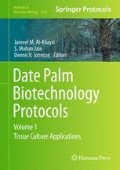Abstract
The health benefits of dates arise from their content of phytochemicals, known for having pharmacological properties, including flavonoids, carotenoids, phenolic acids, sterols, procyanidins, and anthocyanins. In vitro cell culture technology has become an attractive means for the production of biomass and bioactive compounds. This chapter describes step-by-step procedures for the induction and proliferation of callus from date palm offshoots on Murashige and Skoog (MS) medium supplemented with plant growth regulators. Subsequently cell suspension cultures are established for optimum biomass accumulation, based on the growth curve developed by packed cell volume as well as fresh and dry weights. The highest production of biomass occurs at the 11th week after culturing. Moreover, this chapter describes methodologies for the extraction and analysis of secondary metabolites of date palm cell suspension cultures using high-performance liquid chromatography (HPLC). The optimum level of catechin, caffeic acid, apigenin, and kaempferol from the cell suspension cultures establishes after the 11th and 12th weeks of culture. This protocol is useful for scale-up production of secondary metabolites from date palm cell suspension cultures.
Access this chapter
Tax calculation will be finalised at checkout
Purchases are for personal use only
References
Johnson DV, Al-Khayri JM, Jain SM (2015) Introduction: date production status and prospects in Asia and Europe. In: Al-Khayri JM, Jain SM, Johnson DV (eds) Date palm genetic resources and utilization. Vol 2: Asia and Europe. Springer, Dordrecht, pp 1–16
El Hadrami A, Al-Khayri JM (2012) Socioeconomic and traditional importance of date palm. Emir J Food Agric 24:371–385
Ozeker E (1999) Phenolic compounds and their importance. Anadolu J AARI 9(2):114–124
Mazid M, Khan TA, Mohammad F (2011) Role of secondary metabolites in defense mechanisms of plants. Biol Med 3(2):232–249
Biglari F, Al-Karkhi AFM, Easa AM (2008) Antioxidant activity and phenolic content of various date palm (Phoenix dactylifera L.) fruits from Iran. Food Chem 107:1636–1641
J’Aiti F, Verdeil JL, El Hadrami I (2009) Effect of jasmonic acid on the induction of polyphenoloxidase and peroxidase activities in relation to date palm resistance against Fusarium oxysporum f. sp. albedinis. Physiol Mol Plant Path 74:84–90
El Hadrami A, Daayf F, El Hadrami I (2011) Secondary metabolites of date palm. In: Jain SM, Al-Khayri JM, Johnson DV (eds) Date palm biotechnology. Springer, Dordrecht, pp 653–674
Vayalil PK (2012) Date fruits (Phoenix dactylifera Linn.): An emerging medicinal food. Crit Rev Food Sci Nutr 52:249–271
Andlauer W, Furst P (2003) Special characteristics of non-nutrient food constituents of plants - phytochemicals. Introductory lecture. Int J Vitam Nutr Res 73:55–62
McCue PP, Shetty K (2004) Inhibitory effects of rosmarinic acid extracts on porcine pancreatic amylase in vitro. Asia Pac J Clin Nutr 13:101–106
Murthy HN, Lee EJ, Paek KY (2014) Production of secondary metabolites from cell and organ cultures: strategies and approaches for biomass improvement and metabolite accumulation. Plant Cell Tissue Organ Cult 118(1):1–16
Taha HS, Bekheet SA, El-Bahr MK (2012) A new concept for production and scaling up of bioactive compounds from Egyptian date palm (Zaghlool) cultivar using bioreactor. Emir J Food Agric 24:425–433
Al-Khayri JM (2012) Determination of the date palm cell suspension growth curve, optimum plating efficiency, and influence of liquid medium on somatic embryogenesis. Emir J Food Agric 24(5):444–455
Al-Khayri JM, Al-Bahrany AM (2012) Effect of abscisic acid and polyethylene glycol on the synchronization of somatic embryo development in date palm (Phoenix dactylifera L.) Biotechnology 11(6):318–325
Al-Bahrany AM, Al-Khayri JM (2012) In vitro responses of date palm cell suspensions under osmotic stress induced by sodium, potassium and calcium salts at different exposure durations. Am J Plant Physiol 7(3):120–134
Taha HS, Abdel-El-Kawy AM, Abd-El-Kareem FM, El-Shabrawi HM (2010) Implement of DMSO for enhancement and production of phenolic and peroxides compounds in suspension cultures of Egyptian date palm (Zaghlool and Samany) cultivars. J Biotech Biochem 1:1–10
Shehata WF, Aldaej MI, Alturki SM, Ghazzawy HS (2014) Effect of ammonium nitrate on antioxidants production of date palm (Phoenix dactylifera L.) in vitro. Biotechnology 13(3):116–125
Murashige T, Skoog F (1962) A revised medium for rapid growth and bioassays with tobacco tissue cultures. Physiol Plant 15:473–497
Acknowledgment
The authors wish to express gratitude to King Abdulaziz City for Science and Technology (KACST), Saudi Arabia, for the financial support of this research project (Grant No. AT-34-63).
Author information
Authors and Affiliations
Corresponding author
Editor information
Editors and Affiliations
Rights and permissions
Copyright information
© 2017 Springer Science+Business Media LLC
About this protocol
Cite this protocol
Naik, P.M., Al-Khayri, J.M. (2017). Extraction and Estimation of Secondary Metabolites from Date Palm Cell Suspension Cultures. In: Al-Khayri, J., Jain, S., Johnson, D. (eds) Date Palm Biotechnology Protocols Volume I. Methods in Molecular Biology, vol 1637. Humana Press, New York, NY. https://doi.org/10.1007/978-1-4939-7156-5_26
Download citation
DOI: https://doi.org/10.1007/978-1-4939-7156-5_26
Published:
Publisher Name: Humana Press, New York, NY
Print ISBN: 978-1-4939-7155-8
Online ISBN: 978-1-4939-7156-5
eBook Packages: Springer Protocols

